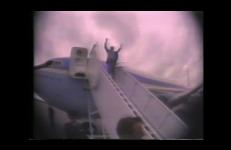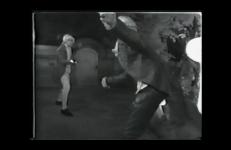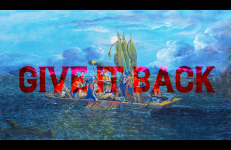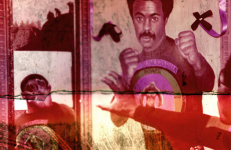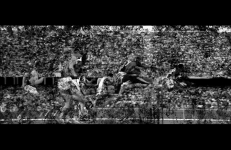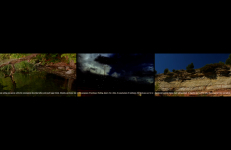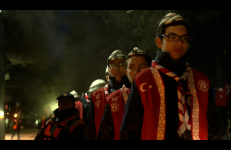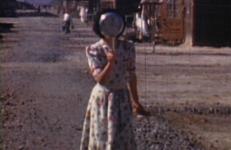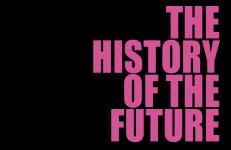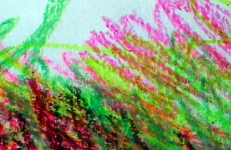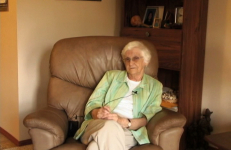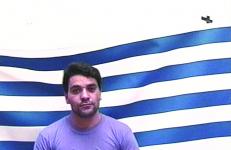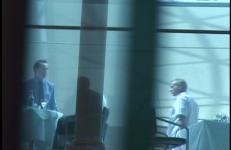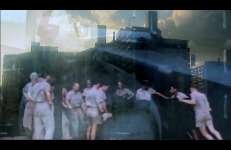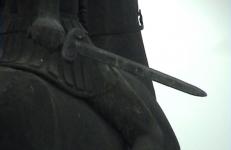In the wake of Lord of the Universe, TVTV planned to cover the impeachment of Richard Nixon, but, unfortunately, Nixon resigned. The group made a ninety-degree turn to covering the “first hundred days” of the Gerald Ford administration, a cavalcade of photo ops and campaign appearances. In Part One of the four-part series, entitled WIN (referring to the Ford slogan, “Whip Inflation Now”), TVTV goes on a whirlwind across-country trek with Ford, stopping in Sioux City, Iowa, Salt Lake City, and Portland. The show is more about Ford’s public than Ford.
History
Arguably, the most successful of the four “Gerald Ford’s America” shows was “Chic To Sheik,” a TVTV tour of the private culture of the official Washington. Lead by Megan Williams, they blithely move around an official White House tea for Betty Ford at the beginning and cavort at the Shah of Iran’s birthday party at the Iranian Embassy at the end. Shot with almost open access because this was when even public people, in private, were innocents before a documentary camera. Washington Post Society Editor, Betty Beale, leads the way. A gem.
Allen Ginsberg (1926-1997) was a leading American poet who gained notoriety in the 1950s and ’60s through his association with the Beat Generation and the San Francisco Renaissance. One of the most controversial poets of his time, his book Howl and Other Poems faced an obscenity trial in 1957 and became one of the most widely read poems of the 20th Century. In the '60s and '70s, Ginsberg studied under gurus and Zen masters.
Swerving between branded content, documentary, and a decolonial episode of MTV 'Cribs', the film revolves around a tour of an apartment which has supposedly been "given back" - led by reformed Native American impersonator, and frequent New Red Order collaborator, Jim Fletcher, alongside profiles of real individuals involved with the voluntary return of land to Indigenous peoples, organizations, and tribes. The film continues New Red Order's ongoing research into instances of settlers returning land to Indigenous peoples, a practice that has been growing exponentially over the past decade.
Give it Back: Stage Theory’s point of departure is the détournement of Panorama of the Monumental Grandeur of the Mississippi Valley (1850), a 9 foot tall, 348 foot long proto-cinematic moving panorama commissioned by and based on the contemporaneous notes and drawings of 19th century amateur archaeologist and glorified grave robber Montroville W. Dickeson — who spent 12 years of his life traveling the Mississippi River and digging up Indigenous burial mounds.
Go-Rilla Means War is a filmic relic of gentrification featuring 35mm film salvaged from a now demolished Black Civil Rights Theater in Bedford-Stuyvesant, Brooklyn. After finding the film unfinished and un-canned on the floor of The Slave Theater, Campbell collaborated with the unknown director (presumably amateur filmmaker Judge John Phillips who owned the Slave Theater) to finish the film.
With an all-female cast, featuring Suzie Bright as John Lennon, Cecilia Dougherty's Grapefruit plays with the romanticized history of the iconic Fab Four, gently mocking John and Yoko’s banal squabbles and obsessive rituals of self-display. Based obliquely on Yoko Ono’s book, the piece works on many levels to reposition this mythic tale of the Beatles by casting '80s women in mod drag—effectively mapping the lesbian sub-culture onto heterosexual mass culture.
Nancy Graves (1939-1995) was a New York sculptor, painter, and filmmaker who used natural history as a reference for dealing with the relationships between time, space, and form.
In this interview she discusses her transition from a static form (sculpture) to a moving form (film), and finally, to painting. “The making of it and the viewing of it are the areas with which I’m most concerned, because I’m an artist, not a philosopher,” Graves says in this interview with Kate Horsfield.
These are the ghosts of a haunted civilization, a culture of progress that hides the social and political horror behind the Olympic Games. These are the haunted figures in the Capitalocene era. A sinister dance of macabre abstraction. Part of the Hauntology series.
Louis Henderson’s work focuses on anti-colonialism and criticizing the neocolonialisation of cyberspace. Born in England in 1983, he graduated from London College of Communication and Le Fresnoy - Studio national des arts contemporains. He recently finished a post-diplôme at the European School of Visual Arts.
A portrait of a studio photographer, Her + Him VAN LEO also examines the photography of the 1940s and 50s from a critical perspective rather than a nostalgic one. This documentary utilizes traditional portrait photography and video in a dialogue between two media: crafted black and white print, and the electronically colored and manipulated screen. This dialog comments on the transformations in art practices and terminologies, and evokes some of the social/urban/political transformations that took place in Egypt over 50 years of its recent history.
Here You Are Before the Trees is a three-channel synchronized video installation. A composite of the three channels presented side by side in one video is available from Video Data Bank for educational use only.
Here You Are Before the Trees traverses Indigenous presence in the Hudson River Valley, Wisconsin, and the areas in-between. Each screen focuses on different homelands and their complex relationships with history, landscape, power and institutional means of oppression.
Each year, crowds of Turkish, Australian and New Zealander tourists travel to Gallipoli, Turkey for a modern day pilgrimage. They honor their fallen soldiers who lost their lives in the Gallipoli/Çanakkale Campaign—one of the bloodiest conflicts of World War One—, which is considered as a defining moment in the establishment of the Turkish nation state as well as the beginning of national consciousness in Australia and New Zealand. With heightened emotions, they move around the historical battlefields, graves and war monuments with the help of guided tours tailored for each community.
A search for a non-existent image, a desire to create an image where there is none,“ leads to Rea Tajiri’s composition on recorded history and non-recorded memory. Framed by the haunting facts of the post-Pearl Harbor Japanese internment camps (which dislocated 120,000 Japanese Americans during World War II), Tajiri creates a version of her family’s story through interviews and historical detail, remembering a time that many people would rather forget.
Welcome to The History of the Future: A Franklin Furnace View of Performance Art. This disc set is based upon a live event that took place at the Abrons Art Center in New York City on April 27, 2007. Within this box set, you'll find performances from that event as well as historical videos that capture the thrills and chills of performance art during the last 30 years.
A desktop video in five parts that modestly propose ways of existing with or against history and politics.
"On my mother’s side there are two lands I come from, separated by the Atlantic ocean, all those fathoms deep. The lands of my grandma and grandpa. I had been through the lands of my grandfather, that is where I still live. The now tamed prairies, missing their bison herds and fenced out into neat geometrical patterns. My grandma comes from a similarly colonized land, Scotland. Ruled by the British Commonwealth and forbidden to speak their language. . . I had never been to Scotland. And I wanted to see my Grandma’s traditional territory.
Hostage: The Bachar Tapes (English Version) is an experimental documentary about "The Western Hostage Crisis." The crisis refers to the abduction and detention of Westerners like Terry Anderson, and Terry Waite in Lebanon in the 80s and early 90s by "Islamic militants." This episode directly and indirectly consumed Lebanese, U.S., French, and British political and public life, and precipitated a number of high-profile political scandals like the Iran-Contra affair in the U.S.
Hostage: The Bachar Tapes (English Version) is an experimental documentary about "The Western Hostage Crisis." The crisis refers to the abduction and detention of Westerners like Terry Anderson, and Terry Waite in Lebanon in the 80s and early 90s by "Islamic militants." This episode directly and indirectly consumed Lebanese, U.S., French, and British political and public life, and precipitated a number of high-profile political scandals like the Iran-Contra affair in the U.S.
How Little We Know of Our Neighbours is an experimental documentary about Britain's Mass Observation Movement and its relationship to contemporary issues regarding surveillance, public self-disclosure, and privacy. At its center is a look at the multiple roles cameras have played in public space, starting in the 1880's, when the introduction of the hand-held camera brought photography out of the studio and into the street. For the first time one could be photographed casually in public without knowledge or consent.
Adapted from psychologist A.R. Luria’s research in the Islamic outskirts of the Soviet Union in the 1930s, How to Fix the World brings to life Luria's conversations with Central Asian farmers learning how to read and write under the unfamiliar principles of Socialism.
Colorful digital animations based on Max Penson's photographs of collective farmers play against a backdrop of landscape images shot in Uzbekistan in 2004.
I Was There is a trilogy of experimental documentary films that explores the problem of radiation, our society's fading collective memory of the atomic bombing of Hiroshima and Nagasaki, and the unresolved debate between ethics and science. These series concern the immediate effects of weaponized nuclear technology, as invisible poison, on the human body.
Newly uncovered 16mm footage from US Army archives recorded the bare land of Hiroshima and the questions of war tactics on the human race immersed in the present time. I Was There is a trilogy of experimental documentary films that explores the problem of radiation, our society's fading collective memory of the atomic bombing and the unresolved debate between ethics and science.
The film reexamines J. Robert Oppenheimer's speech at Princeton Theological Seminary in 1958. I Was There is a trilogy of experimental documentary films that explores the problem of radiation, our society's fading collective memory of the atomic bombing of Hiroshima and Nagasaki, and the unresolved debate between ethics and science. These series concern the immediate effects of weaponized nuclear technology, as invisible poison, on the human body.
This short animation explores various ways to narrate an incident that once took place in the mythical Hotel Carlton. Against images of the deserted hotel today, the artist sketches situations that evoke the rumors that once circulated around the place and the people who inhabited it.
This title is only available on Radical Closure.




